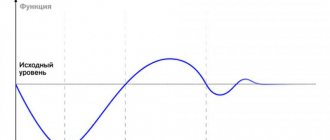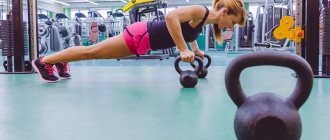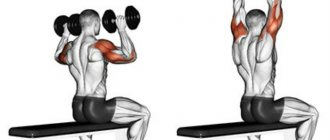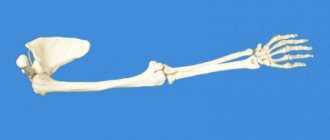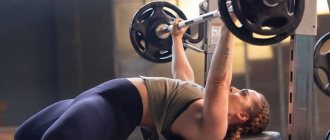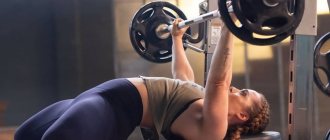Standard training programs for increasing body weight and muscle include the idea of maximum load. That is, when performing an approach, the athlete determines the maximum allowable weight and works up to 90% of this value until his muscles reach a state of maximum fatigue. But recent studies report that it is not so simple, because working with light weights can provide the same result. This statement gave rise to an ongoing debate about whether it is better to train a lot and a little, or a little.
Definition of light weights
Light weight is traditionally understood as the weight that an athlete can lift for 15-20-25 repetitions. Moreover, the ability to perform more than 25 repetitions indicates that the load is too light and needs to be increased.
For exercises such as the deadlift, bench press, and squat, light weights are defined as 55-60% of your heaviest weight per repetition. For exercises such as barbell curls, block rows and barbell rows, you can also be guided by a similar ratio, but it is no longer advisable. Ideally, it is still better to choose a weight based on the number of possible repetitions.
Many professional bodybuilders who actively perform high-repetition training use a weight of 60% of their maximum as a base.
How to train to gain muscle mass. Basic Tips
As mentioned at the beginning, there is no universal recipe, set of exercises, magic products, secret serum, radioactive spider that will turn you into a superhero from the Marvel universe. It all depends on your training goals and your initial preparedness.
One thing we know for sure: you can successfully build muscle even at 70 years old (research on this topic has been conducted, for example), and maintaining muscle tone is not at all necessary by lifting weights
Exercises with your own weight or resistance exercises with rubber loops will be enough. This is exactly what you need if you have never gone to the gym before.
Start by calculating your body fat and lean mass percentage. It’s always useful to build on something to properly distribute the load. By the way, we have a CONVENIENT CALCULATOR that will be useful to you
Here are some general exercises that may be useful:
- Basic without weights (pull-ups on the bar, push-ups from the floor and parallel bars, squats and lunges);
- Resistance exercises with loops;
- Light weights (light dumbbells, medicine balls, etc.);
- Strength training equipment and blocks.
At the initial stage, as a rule, two classes per week are enough for all major muscle groups: torso, legs, arms, back, shoulders. In this case, it is advisable to work through all of them in one workout. The base load should be such that you can perform 12 repetitions in one set.
As soon as your body adapts to the load, you can switch to splits, that is, train individual muscle groups (Typical example of a split: back - triceps; pectoral muscles - biceps; legs - shoulders).
At the first stage, you will inevitably suffer from muscle pain - this is the so-called sore throat. It's okay, all novice athletes have gone through this. The main thing is not to overwork, but also not to slow down. Focus on how you feel and everything will be fine.
Is it possible to pump up with small weights?
When answering the question whether it is possible to pump up with small weights, it is recommended to first determine the meaning of the word “pump up”. You most likely will not be able to become a full-fledged athlete with the help of light loads, but it is quite possible to significantly improve your physical fitness.
Experienced trainers give novice athletes light weights so that they can get used to the exercises and better hone their technique. It is with the help of low loads that athletes strengthen their muscles before moving on to heavy weights.
By moving to heavy weights, an athlete exposes his muscles to more and more new loads, thereby provoking their growth. Without switching to increased loads, it will not be possible to achieve hypertrophy.
Athletes train their calves, forearms, and upper trapezius with high reps and relatively light weights. This is due to the fact that the muscles located in the described places are accustomed to work, and it is simply not possible to achieve the desired growth from them. Training with heavier weights for fewer repetitions will definitely not give the same result.
In addition, not everyone is able to firmly hold a heavy barbell with their hands. At the same time, light weight can be held without any problems and for a greater number of repetitions.
Interesting articles:
How to pump up your arms with elastic bands
How to start a car if the battery is dead
Benefits of the diet:
- The diet is quite varied and does not completely exclude essential substances, vitamins and microelements. Even at the first stage, wheat bran is allowed - a source of fiber;
- preference is given to products with a high protein content and low fat content. Thus, protein foods are easily digested, and extra, heavy calories from carbohydrates and fats do not interfere with the fat burning process. The main feature is that muscle mass is preserved. Moreover, proteins contain amino acids that keep teeth, hair and nails in good condition. Little time is given to protein nutrition, so the phase will not cause any harm. Many athletes adhere to this diet for months, and liver and kidney tests show good results;
- The last stage of the diet does not prohibit the consumption of favorite foods, and this helps the body not to experience stress and lack of nutrients, which worsens metabolism. After leaving the diet, the body, accustomed to variety in the menu, will not store fats in the “depot”;
- Simple carbohydrates are allowed, namely fruits and cocoa. In the presence of such substances, sugars, hypoglycemia and loss of strength, which can occur with complete abstinence from sugar, do not occur;
- All vegetables are allowed, and at some stages even starchy ones, so solid dietary fiber supports normal intestinal function.
What happens to muscles when exercising with light weights
When training with light weights, muscles don't work quite as well as is commonly believed. Even if you perform the desired exercise to failure, you will not be able to achieve significant growth. When working with light weight, the muscles do not overcome anything and adapt perfectly. There will be no interruptions in the process. This means that the conditions for muscle growth are not met.
In fact, everything directly depends on the person’s preparedness. If at the first workout the weight of 10 kg turns out to be quite heavy, then the muscles will feel the load accordingly. However, if you refuse to regularly increase weight, muscle growth will be insignificant. All light weights contribute to the development of endurance, but not full-fledged hypertrophy.
Why fast fat loss is so much better than slow fat loss
Ideally, the vast majority of people want to lose excess weight as quickly as possible. In other words, they are trying to do everything possible to speed up fat loss while maintaining muscle.
While this may seem like an obvious choice, there is a very popular school of thought in the fitness world that advocates a “slow” approach to weight loss. That is, using a moderate caloric deficit with light to moderate exercise to slowly reduce fat mass over several months.
In reality, there are not many benefits to slow cutting and quite a few serious disadvantages due to the physiological changes that occur in the body when you restrict your calorie intake to lose weight.
The fact is, the longer you stay in a calorie deficit...
The more your metabolism slows down, which means you need to either reduce food intake or increase energy expenditure.
This is how “metabolic adaptation” works: our metabolism adapts to the amount of energy we consume and tries to balance the amount of energy we burn with the amount we consume—trying to maintain equilibrium (homeostasis).
When you limit the amount of food you eat and lose excess fat, your metabolism naturally begins to slow down (your body burns less energy). And the longer you stay in a calorie deficit, the more your metabolism slows down.
This cycle continues until you reach your goal or until your metabolism slows down so much that you have to give up your weight loss quest and try to speed up your metabolism.
It's certainly not the end of the world, but it's just not necessary!
By being more aggressive with calorie restriction, which we'll talk about now, you can lose a lot more fat without losing muscle or experiencing additional metabolic slowdown.
The longer your muscles don't grow.
This is an insidious drying mistake that can really hurt your long-term results.
Even if you're not a fitness expert, you've probably heard that it's impossible to gain muscle mass and burn excess fat at the same time. This isn't always the case (it can happen in a new athlete), but it's generally true: a caloric deficit impairs the body's ability to repair and synthesize muscle proteins, causing muscle growth to stop.
So the problem with slow cutting becomes clear: the longer you burn fat, the longer you are unable to truly build muscle.
If you've already reached your genetic potential for muscle growth, you shouldn't worry about this. But if you want to add more muscle to achieve your desired aesthetic physique, then this is crucial. When you gain muscle mass, you gain it with accompanying fat deposits, and therefore periodically you need to “dry out.” As a result, the entire process of mass gain can last several years and consists of alternating periods of mass gain and periods of drying the body.
The bottom line is that when it comes to gaining muscle mass and strength over the long term, you want to be in a caloric deficit for as little time as possible, and in this regard, slow cutting is clearly not an option.
The higher the likelihood that you will break down ahead of time and abandon everything due to physical and psychological fatigue.
Let's face it: even if you eat very smartly, any diet gets boring after a while.
It becomes more and more difficult to exercise while drying the body, and the lack of energy is more noticeable, the feeling of hunger appears more and more often, so in order to complete the task you have to rely only on willpower and discipline.
Unfortunately, this happens all too often: the longer someone restricts their food intake, the more likely it is that he or she will eventually give up on the goal altogether and start binge-eating.
Generally speaking, "quick body drying" involves one or two weeks of moderate fasting, and then a "smooth glide."
Rules for training with light weights
So that training with light weights is quite effective. It is necessary to adhere to several basic rules:
- Repeat until failure. All exercises must be done until complete exhaustion and a burning sensation in the muscles. In some cases, it is even advisable to use so-called forced repetitions, in which a partner helps you complete a few more lifts.
- Using standard exercises. There are no special exercises for light weights, so you need to do everything the same as with a normal load.
- Gradual increase. Even training with light weights requires progress. Without weight gain, it is very difficult to talk about any serious effect. It is advisable to use 15 repetitions as a guideline. If an athlete can perform more than 15 repetitions with a certain weight, then it is advisable to slightly increase the load.
It is worth considering that, despite the effectiveness of training with light weights, you will still have to move on to weights. Especially if the athlete has set his goal to build muscle mass.
Other interesting questions and answers
If you get a tattoo on thin arms and then get pumped up, what will happen to the tattoo?
I don’t know how it was in the hall, I saw a slightly different effect.
We had a guy who worked for us in the army and made a wolf on his shoulder. Well, I did it and did it. After the army, his beloved was waiting for him, they started a strong, friendly family with traditions of eating before bed like the last time.
It all ended when in the summer, while playing volleyball, this guy stayed in his T-shirt. As we later found out, after the army he gained 20-30 kg. It was a pity to look at the wolf. From a bloodthirsty predator, he turned into a soft toy from a roadside shop on the M2 highway. The contours swam and the wolf's mug (as well as its owner) was bursting at the seams.
I think this comrade still dreams of returning his faithful friend to his former military glory and menacing grin.
Stepan Bugaev 257
Do you think it is better to be wiry or pumped?
Sorry, but what is “wiry” or “pumped up”. I’ve been in sports since 1968, but I don’t know these terms. Maybe “wiry” means strong but thin, and pumped up means muscular but weak? All the same, to me, a specialist in the field of physical culture and sports, your terms are incomprehensible. I'll try to explain. In a normal, developed man, muscle mass ranges from forty to fifty-five percent of body weight. Anything higher is an inflection point. Or according to your concept, “over-pumped”. A man whose muscle mass is less than forty percent of his total body mass looks bad. He probably fits your definition of “wiry,” since men with little muscle mass can actually be quite strong. I think that the ideal option would be intermediate or mixed - a man with muscle mass of at least fifty percent of the total body weight, but with the strength of a “wiry” man.
When is training with light weights necessary?
Both beginners and experienced athletes can train with light weights. Typically, such loads are used during the drying period, when it is necessary to expend as much energy as possible and at the same time maintain the relief. In this case, the athlete needs to select a weight with which he can perform up to 20 repetitions within each repetition. But fatigue should also occur, since without it there will be no point in training.
When working with light loads, it is recommended to reduce the rest period between repetitions. Blood should not be allowed to flow away from the muscles. In most cases, 40-60 seconds is enough to restore strength before the next repetition.
Light weights are effective in the following cases:
- during explosive training;
- with active fat burning;
- when overtraining occurs;
- in the process of recovery from severe injuries or sprains;
- completing grueling workouts with heavy weights.
Thus, it is indeed possible to start with light weights, but using an increased load will allow you to achieve much greater success. All athletes who, for some reason, cannot or do not want to work with heavy weights can easily resort to small weights. This approach is less likely to cause injury or strain. In this case, it is advisable to follow the technique of performing the exercises, since otherwise it will be very difficult to guarantee effectiveness.
Phillips experiment
Professor Stuart Phillips studies the effects of exercise on muscles. Several years ago, he gathered a group of novice athletes and conducted an experiment. Some of the novice athletes adhered to the traditional load schedule with heavy weights, while others used lighter weights in training, but increased the number of approaches. The results showed that the performance of both groups was similar. All volunteers, regardless of the weight of the sports equipment, received an identical positive result. Thus, it was proven that the ineffectiveness of loads with light weights is just a myth.
Focus on proper weight loss
Many weight loss tips, due to ignorance or deliberately ignoring the fact that if you lose weight incorrectly, not only fat, but also muscle mass is lost. And this is a serious problem, because we need to lose fat and maintain or even gain muscle. But what to do if to reduce the amount of fat you need to reduce calories, and to build muscle mass, on the contrary, you need to increase it?
A study published in the medical journal PubMed answers this question. It showed that men who ate a diet with a 40% energy deficit, high protein intake, and four weeks of resistance training and high-intensity interval training reduced their body fat while increasing their muscle mass. .
Therefore, you need to not only create a diet with a low amount of substances that increase fat mass, but also include in it the amount of protein that will satisfy the norm of energy consumption.
What ratio of calories do you need? Many athletic trainers recommend the following: 40% protein, 40% carbohydrates and 20% fat. There is no generally accepted exact data on the amount of protein, but according to another study published in PubMed, it is recommended to consume 1.6 grams of protein per kilogram of body weight per day to achieve maximum adaptation to resistance training and effective muscle building.
Train properly
When you go on a calorie-restricted diet and start doing strength training or cardio, you'll notice how easily you start to lose strength during the workout. Therefore, many trainers advise performing supersets - a combination of two exercises designed to work the same muscle or antagonist muscles (for example, biceps and triceps and quadriceps, chest and back, and so on). Moreover, the superset should be performed without rest in order to pump blood into the muscles as much as possible.
And only after completing all the exercises can you rest. But rest does not mean lying on the bed, but lighter activity between supersets (for example, jumping rope, squats and other activities that are not strength exercises). Rest does not have to be intense - the main thing is that it is active. This way you will maintain approximately the same heart rate without pulse fluctuations from a peak at the end of the approach to a minimum during sedentary rest.
The idea behind these workouts is that active rest helps better deplete the body's supply of carbohydrates. And when carbohydrates are depleted, fat deposits begin to be burned.
Metabolic stress
Even if not everyone knows what it is, everyone is familiar with a strong burning sensation in the muscle during exercises of ~12 repetitions per set and above.
What is metabolic stress? Long muscle contraction compresses the blood vessels and “locks” the blood in the cells. New blood with oxygen does not temporarily enter the cell and metabolic products (lactate, hydrogen ions, inorganic phosphate) do not leave it. A kind of chemical poisoning of the cell occurs, there is a risk of its death, and in response to this the body again decides to strengthen itself.
There is a version that muscle growth can also be affected by “pumping” - swelling of the muscle after training, giving it volume for several hours. Scientists suggest that excess water in the cell stretches it. The cell again perceives this as a threat to its integrity and sends anabolic signals that trigger growth.
How to build muscles: basic requirements
Building muscle requires at least 2 fundamental principles.
- Progressive workouts that can stimulate growth. (A sound training plan = success.)
- A diet that can support muscle growth. (First of all, consume enough calories and protein).
As long as both principles work correctly, regularly and for a long enough time, the muscles will grow.
What should you do and use to make your muscles grow?
As you may have noticed, the main principles of muscle growth do not include a gym membership, training with free weights such as barbells and dumbbells, machines or additional equipment.
And this is because they do not play a decisive role in increasing muscle size and mass growth. These are just useful additions that can help speed up results and improve quality.
And not only in the sense that they will effectively train every muscle group and provide the muscle growth that you so desire. They simplify the progression of loads that is so necessary to stimulate muscle growth and progress in training both at home and in the gym.
That's why all gyms are filled with dumbbells from 2 to 45 kg + in 2 kg increments, barbells and plates from 2.5 kg to 20 kg (also in 2 kg increments); benches that can be adjusted to any angle; racks on which you can perform many exercises; complex, block and various exercise machines for each muscle group.
So I'm not going to lie to you here. If you want to build and pump up beautiful and strong muscles, then applying all of the above will be the best and most effective way to achieve this. Of course, you can do without something, but if you don’t have anything on this list, then this is a big problem.
But, as I already said, everything in this world is possible. There are a large number of different programs and workout options that can be used to build muscle at home without using equipment, and even the most controversial of them can work effectively when used correctly.
